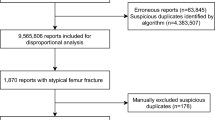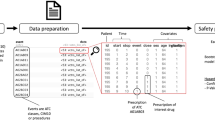Abstract
Background: The risk of myocardial infarction, macular oedema and bone fractures associated with thiazolidinediones (TZDs) has been extensively investigated.
Objective: The aim of the study was to verify if the analysis of a large spontaneous reporting database could generate early signals on these adverse drug reactions (ADRs) associated with TZDs.
Methods: A case/non-case study, restricted to antidiabetic drugs, was performed on spontaneous reports of ADRs (2005–2008) in the US FDA Adverse Event Reporting System (AERS). The method was applied to TZDs, both as a drug class and as single agents. The reporting odds ratio (ROR) with 95% CI was calculated as a measure of disproportionality in the whole dataset and in a quarter-by-quarter analysis.
Results: TZD use was registered in 49 589 out of 301 950 drug-reaction pairs (16%), with significant disproportionality for myocardial infarction (ROR 4.71; 95%CI 4.40, 5.05), macular oedema (3.88; 2.79, 5.39) and bone fractures (1.73; 1.53, 1.96). Separate analysis of the two TZDs showed that only rosiglitazone was associated with myocardial infarction (7.86; 7.34, 8.34) and macular oedema (5.55; 3.94, 7.79), whereas pioglitazone was associated with multiple site fractures (2.00; 1.70, 2.35), in particular upper and lower limb and pelvic fractures. The quarter-by-quarter analysis identified disproportionality for myocardial infarction (3.13; 2.38, 4.10) and bone fractures since January-March 2005 (2.70; 1.04, 2.78).
Conclusions: The frequency of reporting of myocardial infarction, macular oedema and fractures was significantly higher for TZDs in comparison with other antidiabetic drugs, with large intraclass differences. Both myocardial infarction and bone fracture signals appeared before major publications on these safety issues.




Similar content being viewed by others
References
Nissen SE, Wolski K. Effect of rosiglitazone on the risk of myocardial infarction and death from cardiovascular causes. N Engl J Med 2007; 356: 2457–71
Singh S, Loke YK, Furberg CD. Long-term risk of cardiovascular events with rosiglitazone: a meta-analysis. JAMA 2007; 298: 1189–95
Nissen SE, Wolski K. Rosiglitazone revisited: an updated meta-analysis of risk for myocardial infarction and cardiovascular mortality. Arch Intern Med 2010; 170 (14): 1191–201
Lincoff AM, Wolski K, Nicholls SJ, et al. Pioglitazone and risk of cardiovascular events in patients with type 2 diabetes mellitus: a meta-analysis of randomized trials. JAMA 2007; 298: 1180–8
Bilik D, McEwen LN, Brown MB, et al. Thiazolidinediones, cardiovascular disease and cardiovascular mortality: translating research into action for diabetes (TRIAD). Pharmacoepidemiol Drug Saf 2010; 19: 715–21
Bodmer M, Meier C, Kraenzlin ME, et al. Risk of fractures with glitazones: a critical review of the evidence to date. Drug Saf 2009; 32: 539–47
Dormuth CR, Carney G, Carleton B, et al. Thiazolidinediones and fractures in men and women. Arch Intern Med 2009; 169: 1395–402
Douglas IJ, Evans SJ, Pocock S, et al. The risk of fractures associated with thiazolidinediones: a self-controlled caseseries study. PLoS Med 2009; 6: e1000154
Habib ZA, Havstad SL, Wells K, et al. Thiazolidinedione use and the longitudinal risk of fractures in patients with type 2 diabetes mellitus. J Clin Endocrinol Metab 2010; 95: 592–600
Merante D, Menchini F, Truitt KE, et al. Diabetic macular edema: correlations with available diabetes therapies-evidence across a qualitative review of published literature from MEDLINE and EMBASE. Drug Saf 2010; 33: 643–52
Food and Drug Administration. FDA significantly restricts access to the diabetes drug Avandia [online]. Available from URL: http://www.fda.gov/Drugs/DrugSafety/PostmarketDrugSafetyInformationforPatientsandProviders/ucm226956.htm [Accessed 2010 Oct 25]
European Medicines Agency. European Medicines Agency recommends suspension of Avandia, Avandamet and Avaglim [online]. Available from URL: http://www.ema.europa.eu/docs/en_GB/document_library/Press_release/2010/09/WC500096996.pdf [Accessed 2012 Feb 14]
Kessler DA. Introducing MEDWatch: a new approach to reporting medication and device adverse effects and product problems. JAMA 1993; 269: 2765–8
Brown EG. Using MedDRA: implications for risk management. Drug Saf 2004; 27: 591–602
US FDA. The Adverse Event Reporting System (AERS): latest quarterly data files [online]. Available from URL: http://www.fda.gov/Drugs/GuidanceComplianceRegulatoryInformation/Surveillance/ucm082193 [Accessed 2012 Jan 20]
WHO Collaborating Centre for Drug Statistics Methodology. ATC/DDD Index 2010 [online]. Available from URL: http://www.whocc.no/atc_ddd_index/ [Accessed 2010Aug 30]
EUROMEDSTAT. EUROMEDSTAT: a project funded by the European Commission [online]. Available from URL: http://ec.europa.eu/health/ph_projects/2001/monitoring/fp_monitoring_2001_frep_12_1_en.pdf [Accessed 2012 Feb 27]
Food and Drug Administration. Drugs@FDA [online]. Available from URL: http://www.accessdata.fda.gov/scripts/cder/drugsatfda/index.cfm [Accessed 2010 Aug 30]
Egberts AC, Meyboom RH, van Puijenbroek EP. Use of measures of disproportionality in pharmacovigilance: three Dutch examples. Drug Saf 2002; 25: 453–8
Moore N, Kreft-Jais C, Haramburu F, et al. Reports of hypoglycaemia associated with the use of ACE inhibitors and other drugs: a case/non-case study in the French pharmacovigilance system database. Br J Clin Pharmacol 1997; 44: 513–8
Bate A, Evans SJ. Quantitative signal detection using spontaneous ADR reporting. Pharmacoepidemiol Drug Saf 2009; 18: 427–36
Hauben M, Madigan D, Gerrits CM, et al. The role of data mining in pharmacovigilance. Expert Opin Drug Saf 2005; 4: 929–48
Almenoff JS, Pattishall EN, Gibbs TG, et al. Novel statistical tools for monitoring the safety of marketed drugs. Clin Pharmacol Ther 2007; 82: 157–66
Centers for Disease Control and Prevention. Epi Info_[online]. Available from URL: http://www.cdc.gov/epiinfo [Accessed 2010 Aug 30]
Almenoff J, Tonning JM, Gould AL, et al. Perspectives on the use of data mining in pharmaco-vigilance. Drug Saf 2005; 28: 981–1007
Ahmed I, Thiessard F, Miremont-Salame G, et al. Pharmacovigilance data mining with methods based on false discovery rates: a comparative simulation study. Clin Pharmacol Ther 2010; 88: 492–8
van Puijenbroek EP, Bate A, Leufkens HG, et al. A comparison of measures of disproportionality for signal detection in spontaneous reporting systems for adverse drug reactions. Pharmacoepidemiol Drug Saf 2002; 11: 3–10
Chen Yan, Guo JJ, Steinbuch M, et al. Comparison of sensitivity and timing of early signal detection of four frequently used signal detection methods: an empirical study based on the US FDA Adverse Event Reporting System Database. Pharm Med 2008; 22: 359–65
Food and Drug Administration. Reports received and reports entered into AERS by year [online]. Available from URL: http://www.fda.gov/Drugs/GuidanceComplianceRegulatoryInformation/Surveillance/AdverseDrugEffects/ucm070434.htm [Accessed 2010 Aug 30]
Cohen A, Rabbani A, Shah N, et al. Changes in glitazone use among office-based physicians in the U.S., 2003–2009. Diabetes Care 2010; 33: 823–5
Shah ND, Montori VM, Krumholz HM, et al. Responding to an FDA warning: geographic variation in the use of rosiglitazone. N Engl J Med 2010; 363: 2081–4
Piccinni C, Motola D, Marchesini G, et al. Assessing the association of pioglitazone use and bladder cancer through drug adverse event reporting. Diabetes Care 2011; 34 (6): 1369–71
Willemen MJ, Mantel-Teeuwisse AK, Straus SM, et al. Use of dipeptidyl peptidase-4 inhibitors and the reporting of infections: a disproportionality analysis in the World Health Organization VigiBase. Diabetes Care 2011; 34: 369–74
Allegato I: riassunto delle caratteristiche del prodotto [online]. Available from URL: http://www.ema.europa.eu/docs/it_IT/document_library/EPAR_-_Product_Information/human/000285/WC500021386.pdf [Accessed 2012 Jan 20]
Hauben M, Patadia V, Gerrits C, et al. Data mining in pharmacovigilance: the need for a balanced perspective. Drug Saf 2005; 28: 835–42
Hauben M, Reich L, DeMicco J, et al. ‘Extreme duplication’ in the US FDA Adverse Events Reporting System database. Drug Saf 2007; 30: 551–4
Hartnell NR, Wilson JP. Replication of the Weber effect using postmarketing adverse event reports voluntarily submitted to the United States Food and Drug Administration. Pharmacotherapy 2004; 24: 743–9
Pariente A, Gregoire F, Fourrier-Reglat A, et al. Impact of safety alerts on measures of disproportionality in spontaneous reporting databases: the notoriety bias. Drug Saf 2007; 30: 891–8
Stephenson WP, Hauben M. Data mining for signals in spontaneous reporting databases: proceed with caution. Pharmacoepidemiol Drug Saf 2007; 16: 359–65
Nathan DM, Buse JB, Davidson MB, et al. Medical management of hyperglycemia in type 2 diabetes: a consensus algorithm for the initiation and adjustment of therapy. A consensus statement of the American Diabetes Association and the European Association for the Study of Diabetes. Diabetes Care 2009; 32: 193–203
Petri H, Urquhart J. Channeling bias in the interpretation of drug effects. Stat Med 1991; 10: 577–81
Acknowledgements
This research was supported by institutional funds from the University of Bologna. The authors have no conflicts of interest that are directly relevant to the content of this study.
Author information
Authors and Affiliations
Corresponding author
Rights and permissions
About this article
Cite this article
Motola, D., Piccinni, C., Biagi, C. et al. Cardiovascular, Ocular and Bone Adverse Reactions Associated with Thiazolidinediones. Drug Saf 35, 315–323 (2012). https://doi.org/10.2165/11596510-000000000-00000
Published:
Issue Date:
DOI: https://doi.org/10.2165/11596510-000000000-00000




